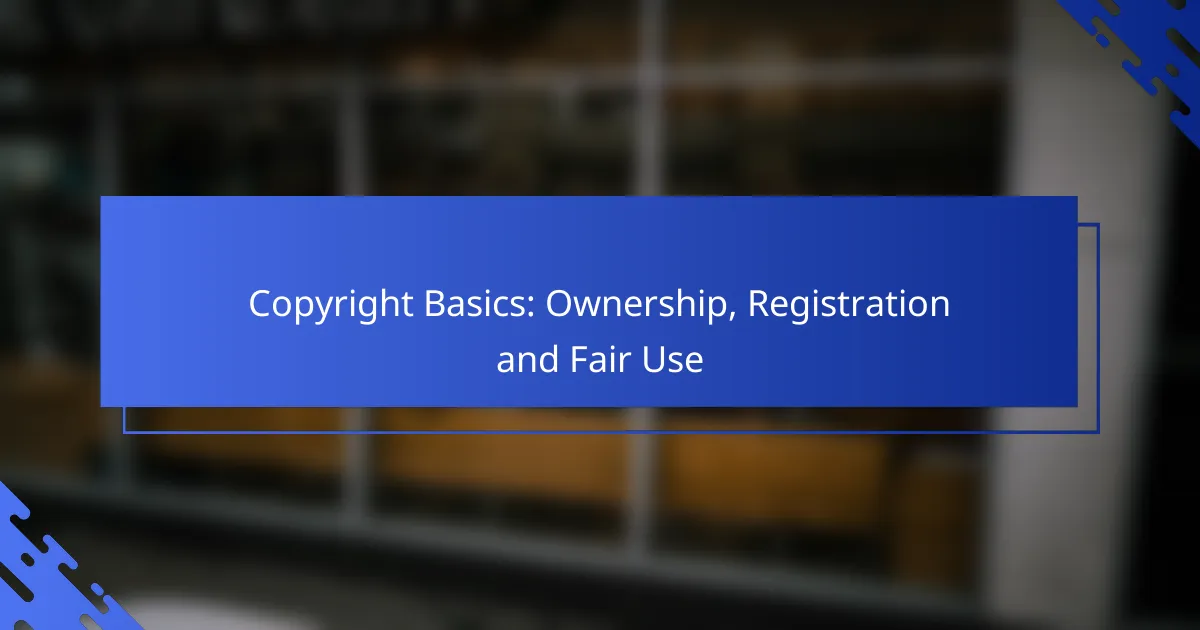Copyright is a vital legal framework that grants creators exclusive rights over their original works, ensuring protection of intellectual property. Registering your copyright with the U.S. Copyright Office not only secures these rights but also offers legal advantages in cases of infringement. Additionally, the doctrine of fair use permits limited use of copyrighted material, striking a balance between the rights of creators and the public’s access to information and creativity.
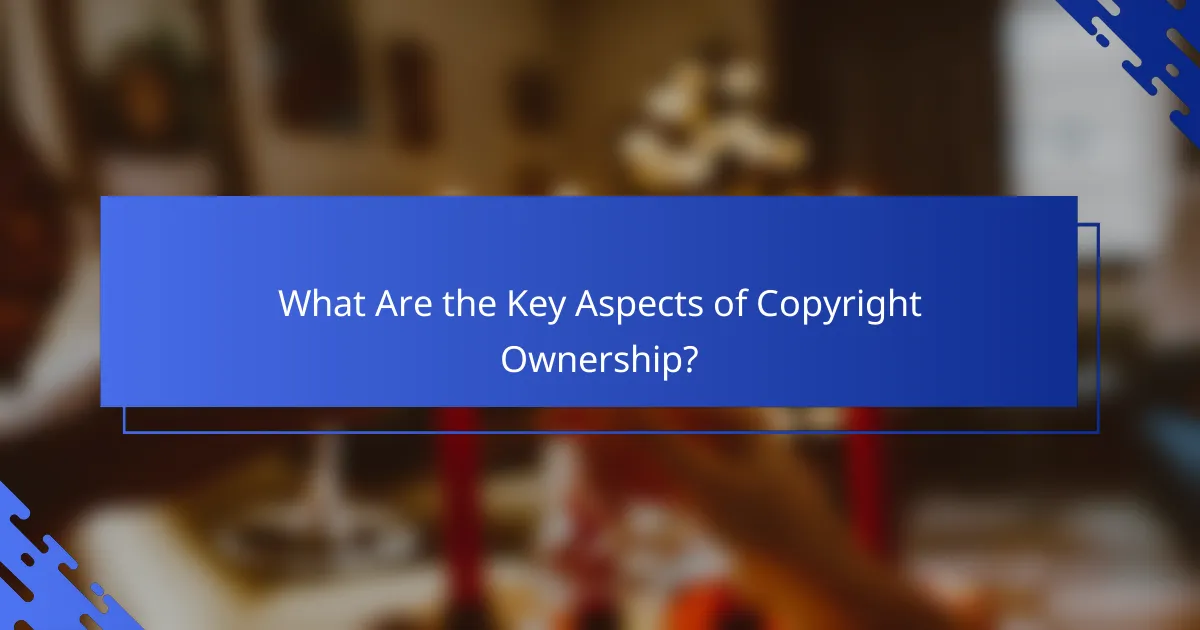
What Are the Key Aspects of Copyright Ownership?
Copyright ownership refers to the legal rights granted to creators over their original works. Understanding the key aspects of copyright ownership is essential for protecting intellectual property and ensuring proper use of creative materials.
Definition of copyright ownership
Copyright ownership is the exclusive right to use, reproduce, and distribute a creative work. This includes literary, musical, and artistic works, as well as software and other forms of media. The owner has the authority to control how their work is used and to benefit financially from it.
Types of copyright owners
There are generally two types of copyright owners: individual creators and organizations. Individual creators are often the original authors or artists, while organizations may hold rights through employment agreements or contracts. In some cases, a work can be owned by multiple parties, leading to joint ownership scenarios.
Duration of copyright ownership
The duration of copyright ownership typically lasts for the life of the creator plus an additional 70 years in many jurisdictions, including the United States and European Union. For works created by organizations, copyright may last for 95 years from publication or 120 years from creation, whichever is shorter. These timeframes can vary by country, so it’s important to check local laws.
Transfer of ownership rights
Copyright ownership rights can be transferred through assignments or licenses. An assignment involves a complete transfer of rights from the original owner to another party, while a license allows the original owner to retain ownership while granting specific usage rights to others. It’s crucial to document these agreements clearly to avoid disputes.
Joint ownership scenarios
Joint ownership occurs when two or more parties create a work together and share copyright. Each owner has equal rights to use the work, but they must agree on how to manage and exploit it. Disagreements can arise, so it’s advisable to establish clear terms regarding usage, revenue sharing, and decision-making processes in advance.

How to Register Copyright in the United States?
To register copyright in the United States, you must submit an application to the U.S. Copyright Office. This process secures your rights as a creator and provides legal benefits in case of infringement.
Steps for copyright registration
The first step in copyright registration is to complete the appropriate application form, which can be done online or via mail. Next, you will need to submit a copy of the work you wish to register, along with the required fee. Finally, after processing, you will receive a certificate of registration confirming your copyright.
It’s advisable to keep a record of your submission, including dates and any correspondence with the Copyright Office. This documentation can be useful if you need to prove ownership later.
Required forms and fees
Be aware that additional fees apply for special services, such as expedited processing or registration of multiple works. Always check the U.S. Copyright Office website for the most current fee schedule.
Benefits of registration
Registering your copyright provides several advantages, including the ability to sue for statutory damages and attorney’s fees in case of infringement. It also serves as public notice of your ownership, which can deter unauthorized use of your work.
Additionally, registered works can be more easily licensed or sold, enhancing their commercial value. Overall, registration is a crucial step for creators looking to protect their intellectual property effectively.
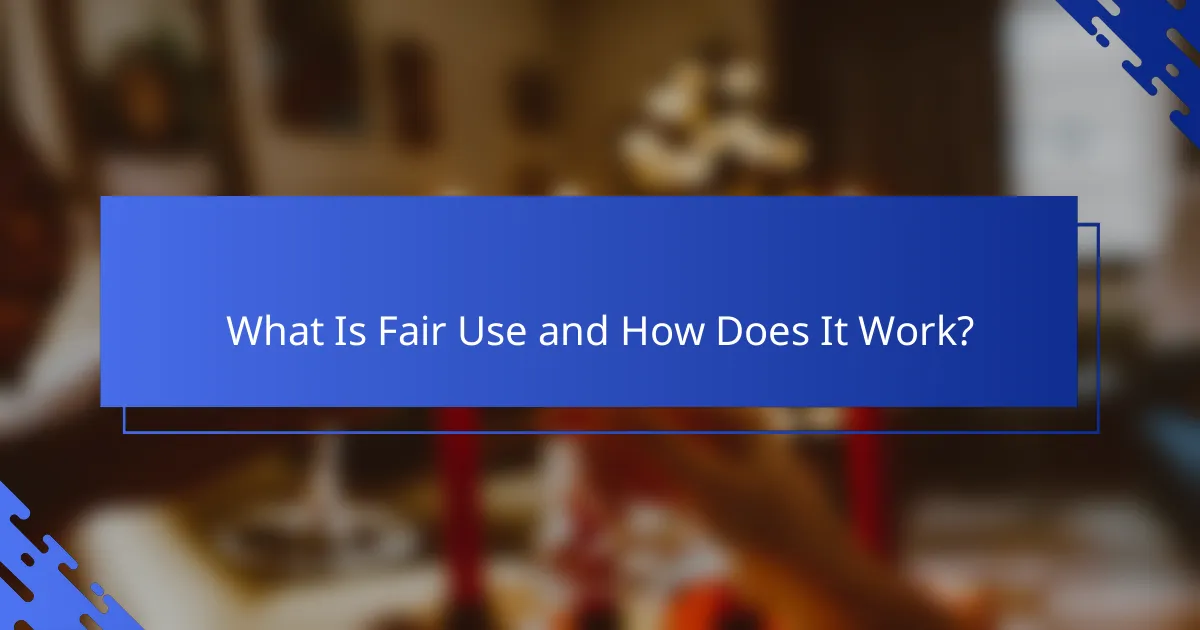
What Is Fair Use and How Does It Work?
Fair use is a legal doctrine that allows limited use of copyrighted material without permission from the rights holder. It is primarily intended to balance the interests of copyright owners with the public’s interest in the dissemination of information and creativity.
Definition of fair use
Fair use refers to the ability to use a portion of copyrighted work for specific purposes such as criticism, comment, news reporting, teaching, scholarship, or research. This concept is rooted in U.S. copyright law and aims to promote freedom of expression while protecting the rights of creators.
It is important to note that fair use is not a blanket permission; rather, it is determined on a case-by-case basis, considering various factors that evaluate the nature and purpose of the use.
Four factors of fair use
The determination of fair use is based on four key factors:
- Purpose and character of the use: Non-commercial, educational, or transformative uses are more likely to be considered fair use.
- Nature of the copyrighted work: Using factual works is more favorable for fair use than using creative works.
- Amount and substantiality: Using a small portion of a work is more likely to be fair use, especially if it does not capture the essence of the original.
- Effect on the market: If the use negatively impacts the market for the original work, it is less likely to be considered fair use.
Examples of fair use cases
Common examples of fair use include quoting a few lines from a book in a review, using a short clip from a film in a critique, or incorporating images in a classroom presentation. These instances typically involve minimal portions of the original work and serve educational or commentary purposes.
Another example is parody, where a work is transformed to comment on or criticize the original. Courts often view such uses favorably, as they contribute to public discourse and creativity.
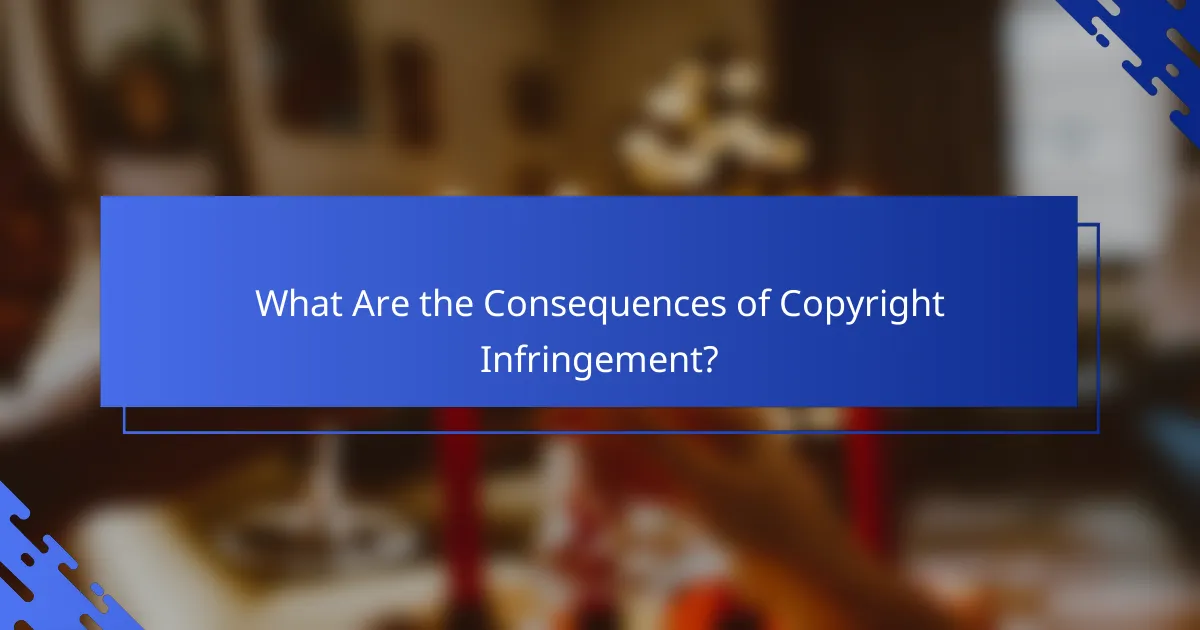
What Are the Consequences of Copyright Infringement?
Copyright infringement can lead to serious legal, financial, and reputational consequences for individuals and businesses. Understanding these repercussions is crucial for anyone involved in creative work or content distribution.
Legal penalties for infringement
Legal penalties for copyright infringement can include civil lawsuits, where the copyright owner may seek injunctions to stop the infringing activity and demand damages. In some cases, willful infringement can lead to criminal charges, resulting in fines or even imprisonment.
In the United States, statutory damages can range from hundreds to thousands of dollars per work, depending on the severity of the infringement. Other countries have similar frameworks, often with varying thresholds for penalties.
Financial damages and remedies
Financial damages for copyright infringement can be substantial, potentially leading to significant monetary losses for the infringer. Copyright owners can claim actual damages, which include lost profits, or statutory damages, which are predetermined amounts set by law.
Remedies may also include the payment of attorney fees and costs associated with litigation. In some jurisdictions, the infringer may be required to pay for profits gained from the infringement, further increasing financial liability.
Impact on reputation
Infringing on copyright can severely damage an individual’s or organization’s reputation. Businesses may face public backlash, loss of customer trust, and negative media coverage, which can impact future opportunities.
Moreover, a tarnished reputation can lead to difficulties in forming partnerships or securing funding, as stakeholders often prefer to associate with entities that respect intellectual property rights.
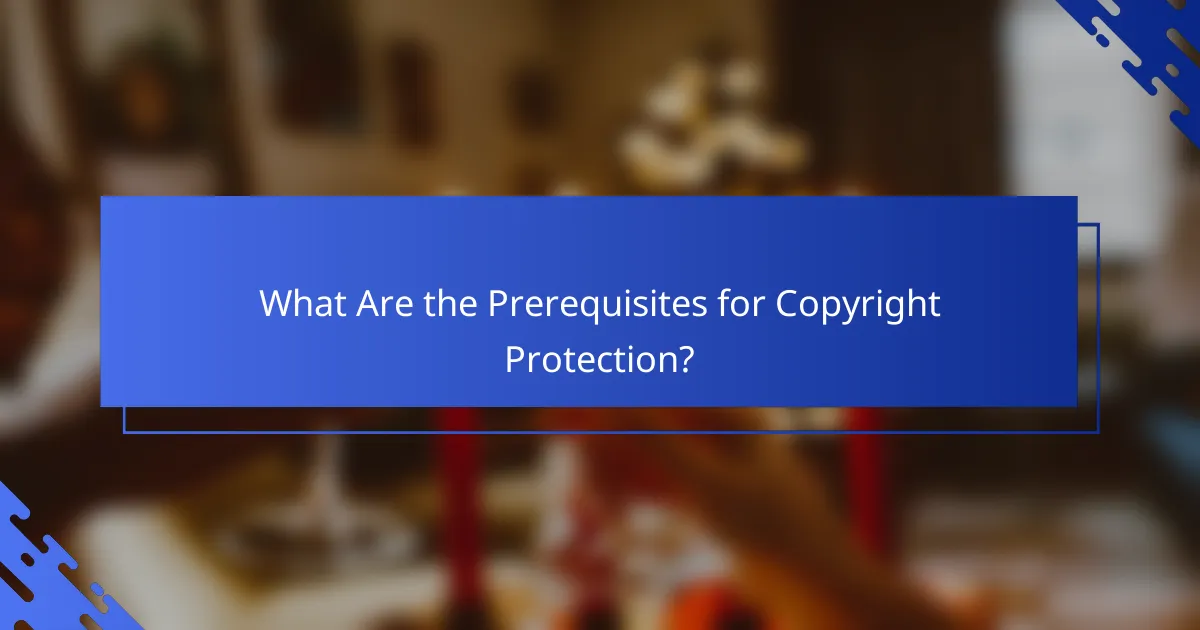
What Are the Prerequisites for Copyright Protection?
To qualify for copyright protection, a work must meet two main prerequisites: it must be original and fixed in a tangible medium. These criteria ensure that the work is both a product of creativity and recorded in a way that can be perceived, reproduced, or otherwise communicated.
Originality requirement
The originality requirement mandates that a work must be independently created and possess a minimal degree of creativity. This means that even simple or basic works can qualify, as long as they are not copied from another source. For example, a unique painting or a novel story idea can be considered original.
However, originality does not mean that the work must be groundbreaking. Many everyday creations, such as a blog post or a song, can meet this standard as long as they reflect the creator’s own expression. It’s crucial to avoid plagiarism, as copying someone else’s work will disqualify it from copyright protection.
Fixation requirement
The fixation requirement states that a work must be fixed in a tangible medium of expression to be eligible for copyright. This means that the work must be captured in some form, such as written on paper, recorded on a digital device, or saved in a file format. Works that exist only in the creator’s mind do not qualify.
Examples of fixation include a manuscript saved on a computer, a song recorded on a CD, or a sculpture made from clay. It’s important to ensure that the work is documented in a way that can be perceived by others, as this is a key step in securing copyright protection.

How Does Copyright Differ from Other Intellectual Property?
Copyright protects original works of authorship, such as literature, music, and art, while other forms of intellectual property, like trademarks and patents, cover different aspects of innovation and branding. Copyright grants creators exclusive rights to use and distribute their works, whereas trademarks protect brand identifiers and patents safeguard inventions.
Comparison with trademarks
Copyright and trademarks serve distinct purposes. Copyright covers creative expressions, while trademarks protect symbols, names, and slogans that distinguish goods or services in the marketplace. For example, a book’s text is copyrighted, but the title of the book can be trademarked.
Trademarks require use in commerce to maintain protection, whereas copyright protection is automatic upon creation. This means that a trademark must be actively used and renewed, while copyright lasts for the life of the author plus several decades, depending on jurisdiction.
Comparison with patents
Copyright differs significantly from patents, which protect inventions and processes. While copyright covers artistic and literary works, patents are granted for new inventions, providing exclusive rights to the inventor for a limited time, typically 20 years. For instance, a novel is protected by copyright, but a new type of engine would require a patent.
Obtaining a patent involves a rigorous application process and examination, whereas copyright is automatically granted upon creation. This makes copyright more accessible for creators, while patents require a deeper understanding of legal requirements and often substantial investment in time and resources.
